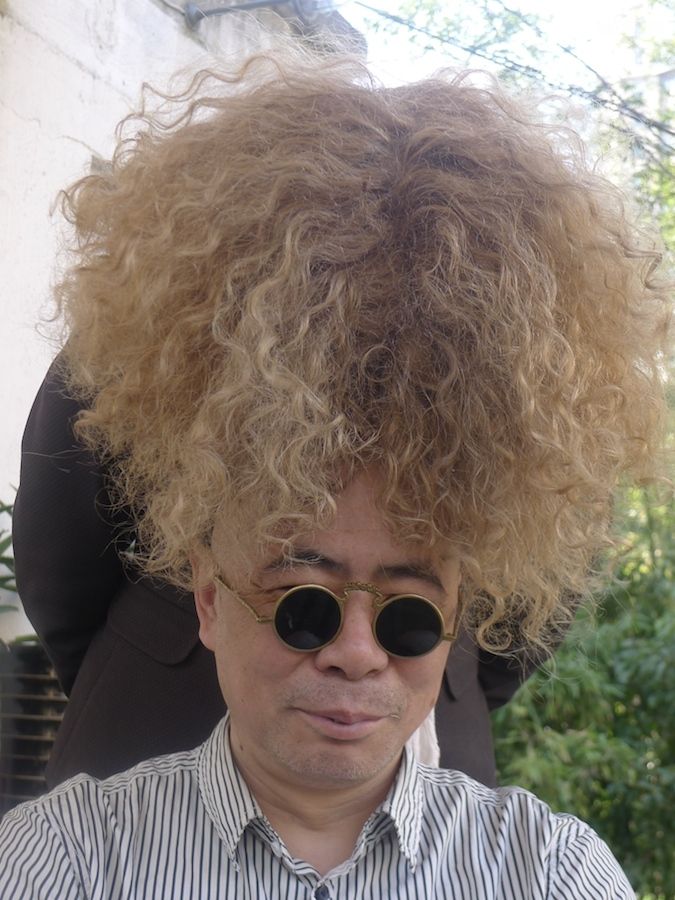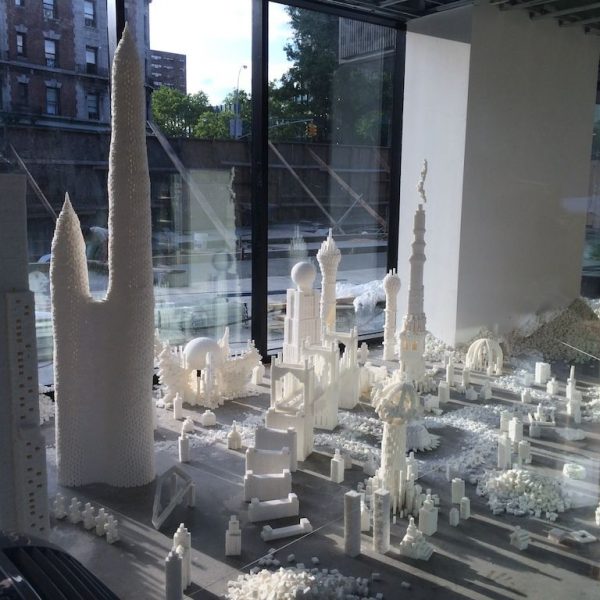
EDITED BY 編輯 x HARRY LIU 劉競晨
TEXT BY 撰文 x FION GUNN 菲昂·戈恩
TRANSLATED BY 翻譯 x SUDONG CAI 蔡蘇東
The importance of curation did not come to me at first from a contemporary art exhibition but an exhibition The Silk Road(2004) in British Library. At that time, I was for the first time clearly aware that curation can express substantial information in such a graceful and fantastic manner, and that a curator is able to render such a complex content into a well-organized exhibition language and convey the very idea of exhibition by means of multidimensional and diverse presentations.
In 2006, quite accidentally I had an opportunity to curate an exhibition in China, and that marked the beginning of my curatorial practices. It was an exhibition displaying contemporary art in Ireland, which, honestly, turned out rather dissatisfactory. From that experience, however, I learnt quite a lot; I began to communicate more with the artists around, interact with community groups and access more information, instead of limiting myself to a self-confined world. From then on, I engaged myself more in curatorial practices.
In 2009, I began to realize my role shift as an “artist as curator”—on one hand I have my own artistic pursuit and on the other I research and plan for exhibition projects. In my curatorial practices, I have been paying close attention to the following aspects.
- how to make art available for the widest audience possible without compromising on quality and innovativeness
- how to facilitate diverse practices and diverse viewpoints
- how to gender rebalance public and private collections of contemporary art
- how to achieve positive interaction of international and local art & artists
As an artist at the very frontline of artistic creation, I naturally adopt different perspectives from the other curators in curation. Nevertheless, the role of artist and curator is not binary, it’s not about either/or, surely the art world will be a better environment from having a diversity of curatorial and authorial voices. At the same time, I am in a better position to approach various issues thanks to my role as an artist-curator and responsibilities involved, such as public alienation or even distaste of contemporary art, lack of understanding of the concept of curator, negative impacts of “celebrity” curators on artistic development, isolated and helpless status of artist-curators and so on.
Hence, essential understanding of contemporary art should be enabled in a wider audience so that art in its nature will not be understood as deals and solely related to profit, nor a vague jargon system or something priced astronomically, but an expression of aspiration to create, communicate and take risk. In this issue, we invited and interviewed a number of art practitioners, hopefully staging a discussion about “artist-curator” under current circumstances as well as showcasing difficulties and challenges confronting them in their respective working environments. The artists, curators and artist-curators in question are from various countries and regions, grown up in different cultures and with divergent backgrounds. This issue is hoped to promote art and the concept of curator to more people, therefore encouraging participation in art and enhancing artistic enjoyment for every one of us.
我第一次認識到“策展”的重要性並不是在當代藝術領域的展覽中,而是在大英圖書館的《絲綢之路(The Silk Road)》展覽上,那是2004年,我第一次清楚地認識到“策展”可以將海量的信息轉化成優雅和美妙的表達形式,而“策展人”將龐雜的內容梳理成為線索清晰的展覽語言,并通過立體化、多樣化的呈現方式來傳達展覽理念。
2006年,我很偶然地獲得了一個在中國策劃展覽的機會,那是我第一次開始策展實踐,我策划了一個關於展現愛爾蘭當代藝術整體面貌的展覽,說老實話,那一次的展覽效果其實很不盡如人意,但從那一次的策展經歷當中,我學到了很多,我開始更關注和周圍的藝術家進行交流,和社區團體互動,看更多的資料,而不僅僅是“閉門造車”一樣封閉在自己的小世界里。從那以後,我開始了更多的策展實踐。
到了2009年,我開始認識到自己的身份已經轉變為了“藝術家策展人”,一方面我要進行自己的藝術創作,另一方面,我還要為展覽項目進行調研和策劃。在我的策展實踐當中有以下幾個方面是我非常關注的。
- 如何在不影響創新和藝術作品質量的前提下讓更多的觀眾參與到藝術當中來
- 如何促進和鼓勵不同想法和觀點的交流
- 如何在私人或者公共收藏當中平衡不同性別藝術家的作品
- 如何實現國際化和本地化藝術的良性互動
 作為一名身處創作一線的藝術家,我在進行策展實踐的時候自然會擁有與其他類型策展人不同的視角,但我不覺得“藝術家”和“策展人”是一個二元對立的局面,而且出現多元化的策展模式和聲音對藝術世界的發展無疑是大有幫助的。同時,藝術家策展人的身份和工作內容也使得我可以清楚地看到很多問題,比如大眾對當代藝術的疏遠甚至迴避、對策展人概念的不了解、“明星”策展人對藝術界發展產生的負面影響、藝術家策展人孤立無援的生存狀態等等等等。
作為一名身處創作一線的藝術家,我在進行策展實踐的時候自然會擁有與其他類型策展人不同的視角,但我不覺得“藝術家”和“策展人”是一個二元對立的局面,而且出現多元化的策展模式和聲音對藝術世界的發展無疑是大有幫助的。同時,藝術家策展人的身份和工作內容也使得我可以清楚地看到很多問題,比如大眾對當代藝術的疏遠甚至迴避、對策展人概念的不了解、“明星”策展人對藝術界發展產生的負面影響、藝術家策展人孤立無援的生存狀態等等等等。
為了能夠讓更多的人從本質上來了解當代藝術的理念,來了解藝術的本源並不是買賣與利益,也不是模棱兩可的術語或者是拖著一串零的天文數字的價格,而是人類對於創造、交流、冒險等本質渴望的表達。我們在這一期雜誌的專題當中邀請和採訪了眾多的藝術界人士,希望能為大家還原一個現實環境下的對於“藝術家策展人”的討論,並且展示他們在實際工作中所面對的困境和挑戰,這些藝術家、策展人、藝術家策展人都來自於不同的國家和地區,有著不同的文化和背景,我們希望通過這一期雜誌,人們可以更多的了解藝術、了解策展人概念、從而更多的參與到藝術當中來,享受藝術賦予我們的愉悅。
- 3.Mateusz_Marcinowski_Regeneration2007
- 4.Katarzyna_Zygadlewiczi_Regeneration2007
- 5.Mateusz_Marcinowski_Regeneration2007
- 6.Katarzyna_Zygadlewicz_Regeneration2007
- 7.Agnieszka_Cholewinska_Regeneration2007
- 8.Ola__Gerlach_Regeneration2007
- 9.Ola__Gerlachi_Regeneration2007
- 10.Daria_Burlinska_Regeneration2007
Why Is This Swing Important?
So why is the artist as curator an issue at all? What do we bring to the experience of exhibitions that is any different from the academic, the writer, the museum custodian who dominates the current scene?
Why is this swing important? I believe that the artist-curator is far more likely to have an intuitively visual approach to curating, one which evokes a more direct audience response and one which contextualises the artworks in a fundamentally different way from the theoretical narratives of the academic/critic or the commercial concerns of the gallerist. After all, the latter could be perceived as (and often are) consumers or facilitators of art rather than creators, who have wangled their way into the position of retailers, middlemen and arbiters of public taste.
The artist-curator’s projects are more likely (although certainly not always) to be free from over reliance on text or academic justifications, the premise of our work is first and foremost, the creation and secondly, the explanation (if required), not the other way around. We can provide the personal experience of seeing through a maker’s eyes which affords viewers a greater sense of immediacy and intimacy – our exhibitions are not brokered or mediated by a third party.
It is clear that for many artist-curators the process of collaboration, frustration with the status quo and the desire to initiate something are key factors when we embrace the curatorial role.

For some it was also an adventure, a way of gaining greater control over the exhibition space, for others it was more of a team enterprise, a way of accessing a community of peers and avoiding isolation. Probably for all of us there was something about how we looked at the world when we were children, how we responded to visual or spatial organisation and combinations of different materials that drew us to an interest in curation. This urge to organise a wide range of visual components leads us to develop a skillset discrete from the production of our own personal artwork although it may grow out of it. There are however, many artists who do not share this urge and are not interested in it, most artists I know would rather stick pins in their eyes than have to curate.
Finally, I would like to quote Alex Julyan describing her purpose as artist curator in the most elegant and precise summation of all the ideas expressed by the contributors to this article:
“My purpose is to create clarity within complexity, dialogue between works and dialogue between the works / event and the audience. To pose questions not answers or certainties. To be true to the investment made by the artist in their work and to give them another perspective on it.”
改變正在發生,意義舉足輕重
我們要問,為什麼藝術家充當策展人會是個值得討論的問題?和學術界、撰寫人以及博物館管理員這些手握當今展覽行業支配大權的人相比,我們對他們的策展期待有何不同嗎?
為什麼這樣的轉變很重要?我認為,藝術家策展人對策展有著更敏銳的視覺直感,因而更能夠激發觀眾的反響,同時把藝術品的呈現置於一定的語境中,這種做法完全不同於學術批評的理論化敘事作風,亦與畫廊經營者的商業考量大相徑庭。至於後者,我們不妨把他們看成是(很多時候確實也是)藝術的消費者或者促進者,而不是創造者,他們不過是費盡奇巧,最終成了售賣者、中間商和大眾品味的仲裁者。
藝術家策展人的項目更有可能(儘管也不總是)擺脫文本或者學術認證的過度依賴,我們策展的前提是,首先考慮作品是否具有直觀創造性,其次才是作品的闡釋(如果需要的話),而不是相反過來。我們能從創作者的角度提供更加個人化的體驗,從而使得觀者獲得更強的即場感和親密感——我們的展覽基本沒有經過第三方的安排和調和。
我們可以清晰地看到,對於許多藝術家策展人而言,嶄新的合作流程、對策展現狀的沮喪和想要發起新風潮的渴望便是他們投入策展角色的主要原因。
對於一些人來說,這還是一段冒險的旅程,一種獲得更多展覽空間掌控權的方式。對另外一些人而言,這是一種團隊事業,一種加入同行陣營避免孤軍奮戰的方法。當我們還是小孩時,我們以獨特的方式看待這個世界,我們接觸視覺和空間的不同組成,以及不同物質的組合時也有特殊的體悟,或許正是這些使我們對策展產生了興趣。這種安排各種視覺因素的迫切希望引導著我們創造出一種技藝,這種技藝儘管可能來源於個人的藝術創作,但卻沒有直接關係。然而,許多藝術家卻沒有這種急迫的希望,對策展也無動於衷。我認識的許多藝術家就情願眼裡容沙,也不願自己策展。
最後,我想引用亞利克斯·朱利安(Alex Julyan)的一段話來作結,她精辟地描述了自己為何選擇藝術家策展人身份的原因,也準確地總結了此文中所有藝術家策展人的觀點。
“我的初衷是,于繁複中創造清晰,於作品中促成對話,架設作品、活動和受眾的溝通橋樑。我要做的是,提出問題而不是提供答案或裝神弄鬼。藝術家對於作品的嘔心瀝血,我們敬重有加;我們的精心安排,則給了藝術家看到自己的作品時,有‘驚鴻一瞥’的驚喜。”
Case Study: How I Curate A Show
Time: 3rd – 20th May, 2012
Exhibition: The City & The City: Contested Space
Venue: A.P.T Gallery, London
Inspirations:
- Reading a book by China Miéville called The City and The City, which describes a dystopic metropolis where two cultures occupy the same physical space and have to be trained to un-see each other. The narrative, which is set in a vaguely futuristic/parallel world, reminded me very much of the situation in Jerusalem (on a political level) at first, but I began to see other more widespread paradigms. In so many of our cities divisions are economic, class, cultural, religious or even age related.
- There was a drug related murder in one of the houses around the corner from my home, this was such a shock. I know many of my neighbours, we have an active residents’ association and we’re a culturally diverse community in South London. Generally I go about my business not noticing or seeing drugs related activity because it isn’t part of my own life nor that of my family and friends, so this murder made me think about the people who walk the same streets that I do, but whose lives are parallel and rarely cross mine.
- I also thought about how I, as a woman, exist within what is sometimes a very threatening environment and how women the world over share these concerns and yet, very often the men who share our lives may worry about us but they don’t experience the threats in the same way.
My Own Practice:
I was making small scale sculptures on the theme of urban life and urban expectations as well as large scale paintings which explore the ways in which we seek, accept or reject new experiences.
Curating Steps:
- Identify which of my own artworks would ‘start’ the curatorial conversation
- Look at other artist websites and check out the archive of images which I’ve put together over the years with work by artists I know or am interested in.
- Identify a suitable gallery, in terms of scale, medium etc.
Outcome:
A group exhibition of 21 artists from mainland China, Africa, United Kingdom, Ireland, France and Taiwan, artworks including painting, drawing, mixed media installation, sculpture, photography and film. Each artist had a different interpretation of the theme.
The Unexpected: Sarah Rubidge, a choreographic installation artist, whose featured work was a video installation. She also had the idea of making a textile ‘river’ which would run through the gallery along the floor and have tributaries on the walls and floors which would connect to each artwork. I was a bit concerned at first that this might overpower the individual artworks, but we talked it through, discussed the methodology and decided to give it a go. Five of the featured artists were involved in the installation working as a team, a sort of curatorial ‘hive’.
When we installed the exhibition it was immediately evident that the ‘river’ had been an inspired idea on Rubidge’s part, it gave a wonderful visual narrative and sense of fun to the show.
Audience Engagement:
We also wanted the show to have a generative aspect, so we ran weekly workshops, where adults and children could make ‘architectural’ additions, these were placed on the banks of the ‘river’. Little ‘cities’ grew up in different parts of the space and the exhibition grew in complexity as well as interest for the visitors. The workshops were organised so that lack of skill was no bar to having a good end result and because the materials we provided were easy to manipulate as well as being harmonious with the appearance of the show, the end result was magical.
Achievement:
This ‘hive’ curatorial model has great potential to result in diverse and inclusive exhibitions, the generative aspect of the installation and workshops create new audiences for contemporary art both in a museum or gallery context as well as in other public spaces. It also gives us, as artists and curators, the eye as well as the ear of the people.
案例分析:我是如何策展的
時間:2012年5月3日——20日
展覽主題:城市與城市:對抗空間
場地:倫敦A.P.T畫廊
靈感來源:
- 柴那·米耶維寫過一本書《城與城》,描述了一座反烏托邦的大都市,其中兩種文化共處同一空間,必須加以訓練才能無視對方。這種基於含糊的未來主義和平行世界的敘事,首先讓我想起了耶路撒冷(政治層面上),但漸漸地我也開始看到了其他更加普遍的範例。我們所處的這麼多城市之中,分裂的因素可以是與經濟、階級、文化、宗教,甚至是年齡相關的。
- 在我家附近的一間房子裡,發生了一起與毒品相關的謀殺案,這讓我非常震驚。那裡是倫敦南部一個有著各種文化背景的街區,我認識許多鄰居,我們這些比較活躍的居民還設有社團。我總是忙著自己的事,沒注意到或看到與毒品有關的事情,因為這和我自己,我的家人和朋友的生活扯不上關係。因此這件謀殺案讓我想起那些和我走在同一街道的人,他們的生活和我是平行的,也甚少和我有交集。
- 我同時也想著,作為女性,我是如何生活在這樣一個威脅時有的世界裡,全世界的女性又是如何對待這些擔憂的;往往我們生命的另一半會擔心我們,但是男性卻無法感同身受地體會我們所面對的威脅。
我的個人藝術實踐:
我創作了一批以城市生活及城市期望為主題的小型雕塑,以及旨在探索我們如何尋找、接受或者拒絕新體驗的方式的大型繪畫作品。
策展步驟:
- 確定我的哪件作品將“啟動”我的策展對話。
- 瀏覽其他藝術家的網站,查看我多年來積累的圖庫檔案,其中都是我認識或者感興趣的藝術家作品。
- 尋找合適的畫廊,需要考慮其規模以及展出方法等等。
結果:
21位來自中國大陸、非洲、英國、愛爾蘭、法國和臺灣的藝術家帶來了一場藝術家群展,展品包括油畫、素描、多媒體裝置、雕塑、攝影和錄影作品。每位藝術家對主題的解讀都是不同的。
意外事件:
薩拉·盧比奇(Sarah Rubidge),一位舞蹈裝置藝術家,她的展出作品是一個視頻裝置,她還想要用織物做成一條“河流”貫穿畫廊,其“支流”遍佈牆面和地面,連接起每一件展品。我一開始擔心這樣做會蓋過其他藝術品的獨立呈現效果,但我們經過詳細的討論後決定試試。結果五位參展藝術家加入了這個創意,成了一個團隊,一個所謂的策展“蜂巢”。
當我們布展的時候,我們清楚地看到,“河流”不僅是讓盧比奇無比激動的創作,更是為展覽帶來了極佳的視覺敘事和樂趣。
觀眾參與
我們還希望展覽能夠激勵“生產”,所以我們開辦了每週一次的工作坊,大人和小孩都可以在這“河流”的兩岸添磚加瓦。小“城”漸漸地在各個展覽空間成長,展覽也變得愈發複雜,同時觀眾的興趣也愈發濃厚。在我們的工作坊中,就算參與者不懂如何“建房”,也不會影響最終的效果,因為我們所提供的材料都易於操作,同時吻合展覽的呈現效果,所以最終效果是意料之外的奇妙。
成績
這種“蜂巢”式策展模式有著巨大的潛力,可以實現多樣並包的展覽效果,裝置的可生產元素和工作坊為博物館和畫廊語境下以及其他公共空間的當代藝術帶來了新的受眾。它同時也讓作為藝術家和策展人的我們得以從大眾的角度觀察和聆聽當代藝術展覽。

























